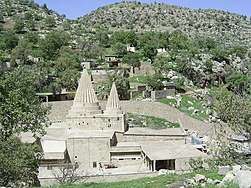Sheikh Adi ibn Musafir
Sheikh ‘Adī ibn Musāfir (Kurdish: شێخ ئادی ,Şêx Adî, born 1072-1078, died 1162)[1] was a Yazidi sheikh of Arab origin,[2] born in the 1070s in the village of Bait Far, in the Beqaa Valley of present-day Lebanon.[3] ‘Adīs house of his birth was – and still is – a place of pious pilgrimage.[4] The Yazidi consider him an avatar of Tawûsê Melek, which means "Peacock Angel". His tomb at Lalish, Iraq is a focal point of Yazidi pilgrimage.[5]
Sheikh Adi Adī ibn Musāfir | |
|---|---|
| Born | 1072-1078 Beyt Far, Baalbek |
| Died | 555-557 Lalish |
| Resting place | Lalish |
| Known for | Yazidism |
| Predecessor | none |
| Successor | Sakhr Abu l-Barakat |
Descending from the family of Marwan Ibn Hakam, the Caliph of the Umayyads, he was raised in a muslim environment.[3] His early life he spent in Baghdad, where he learned from mystics like Abu al-Najib Suhrawardi and Abdul Qadir Gilani. With the latter he undertook a journey to Mecca.[1] With time he became a teacher himself. He chose an ascetic way of life, left Baghdad and settled in Lalish.[6] Despite his desire for seclusion, he impressed the local population with his asceticism and miracles.[7][8] He became well known in present-day Iraq and Syria and disciples moved to the valley of Lalish to live close by Sheikh Adi. Following he founded the Adawiyya order.[9] The Valley of Lalish is located within the environs of the village of Ba'adra, 20 miles to the east of the Nestorian convent of Rabban-Hormizd. He did not marry and had no children.[10] Before he died, he named his successor his nephew Sakhr Abu l-Barakat.[11] As the holiest site in the Yezidi religion, his tomb (marked by three conical cupolas) still attracts a great number of people even outside holy festivals and pilgrimages. Nightly processions by torch light include exhibitions of the green colored pall, which covers the tomb; and the distribution of large trays with smoking harisa (a ragout with coagulated milk).
Physically, he was said to be very tanned and of middle stature. He lived and ascetic lifestyle in the mountains in the region north of Mosul not far from the local Hakkari Kurds. As people flocked to his residency in the hills, he would end up founding a religious order later referred to as al-'Adawiyya ('the followers of 'Adi'). He died between 1162 CE (557 Hijra) and 1160 CE (555 Hijra)[1] in the hermitage that he had built with his followers in the mountain. This hermitage within the Valley of Lalish, would continue to be occupied by his followers and his descendants until the present day despite periods of unrest, destruction, and persecution by outsiders.[12] In 1254, as a result of a violent conflict with the members of the Adawiyya order, the Atabeg of Mosul, Badr al-Din Lu'lu ordered the bones of Sheikh Adi to be exhumed and burned.[13]

See also
Succession
Sheikh Adi ibn Musafir ‘Adawiyya and Yezidi Notables | ||
| Preceded by (None) |
Shaikh of the ‘Adawiyya Ṣūfī Order | Succeeded by Sakhr Abu l-Barakat |
References
- Lescot, Roger (1975). Enquête sur les Yézidis de Syrie et du Djebel Sindjâr. Beirut: Librairie du Liban. p. 22.
- Artur Rodziewicz (2018). The Nation of the Sur: The Yezidi Identity Between Modern and Ancient Myth. p. 269.
- Kreyenbroek, Philip G.; Rashow, Khalil Jindy; Jindī, Khalīl (2005). God and Sheikh Adi are Perfect: Sacred Poems and Religious Narratives from the Yezidi Tradition. Wiesbaden: Otto Harrassowitz Verlag. p. 3. ISBN 978-3-447-05300-6.CS1 maint: date and year (link)
- The Encyclopædia of Islam: A Dictionary of the Geography, Ethnography and Biography of the Muhammadan Peoples. Holland: EJ Brill. 1913. pp. 136–137.
- Spät, Eszter (2005), The Yezidis (2 ed.), London: Saqi, ISBN 0-86356-593-X
- Lescot, Roger (1975). Enquête sur les Yézidis de Syrie et du Djebel Sindjâr. Beirut: Librairie du Liban. p. 24.
- Kreyenbroek, Philip G; Jindy Rashow, Khalil (2005), God and Sheikh Adi are Perfect: Sacred Poems and Religious Narratives from the Yezidi Tradition, Iranica, 9, Wiesbaden: Harrassowitz Verlag, ISBN 3-447-05300-3
- "Yezidi Reformer: Sheikh Adi". The Truth about the Yezidis. YezidiTruth.org. 2007. Archived from the original on 2008-03-20. Retrieved 2007-08-16.
- Lescot, Roger (1975). Enquête sur les Yézidis de Syrie et du Djebel Sindjâr. Beirut: Librairie du Liban. p. 29.
- Kreyenbroek, Philip G.; Rashow, Khalil Jindy; Jindī, Khalīl (2005). God and Sheikh Adi are Perfect: Sacred Poems and Religious Narratives from the Yezidi Tradition. Wiesbaden: Otto Harrassowitz Verlag. p. 4. ISBN 978-3-447-05300-6.CS1 maint: date and year (link)
- Lescot, Roger (1975). Enquête sur les Yézidis de Syrie et du Djebel Sindjâr. Beirut: Librairie du Liban. p. 33.
- Kreyenbroek, Philip G. (1995). Yezidism: Its Background, Observances, and Textual tradition. Lewiston, NY: E. Mellen Press. pp. 27–44. ISBN 9780773490048.
- Lescot, Roger (1975). Enquête sur les Yézidis de Syrie et du Djebel Sindjâr. Beirut: Librairie du Liban. p. 102.